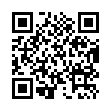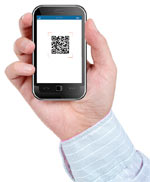How linqr.to works
But what are QR-codes?
The popular QR-code is an easy to scan barcode. It can hold information such as tekst, hyperlinks, e-mail adresses and vcards.

The above links to: http://linqr.to
It is scannable by many smartphone apps (see below). So, no need to remind or type down urls anymore.

It's pretty easy!
QR-Codes are useful! However, other than triggering to scan the code to see what information it holds, they are meaningless for human eyes.
We make them meaningful for human eyes!

Technique
Linqr.to combines recognizable elements from Social Media icons with QR-codes.
We embed both symbols and color patterns from Social Media logo's to achieve the highest recognizability for your custom QR-code, yet preserve readability for common QR-code readers.
Technique in-depth
Linqr.to makes use of QR-code version 3, corresponding to 29 x 29 modules (blocks). QR-code has error correction capability, which has been implemented to correct errors caused by dirt for example. By making use of the highest error correction level available we can deform up to 30 % of the modules of the QR-code. We optimize the output by making it human-eye recognizable on the one hand, and minimize deforming of modules so we preserve a part for actual dirt on the other hand. The QR-code we assert may contain up to 20 alpha-numeric characters . However, it is restricted to use only uppercase alpha-characters.
Short URL service
Since the QR-codes can only hold a limited selection and amount of characters, we have included a short url service with linqr.to. By default we shorten your URL's and forward (HTTP/301) it to the original URL. For example "http://www.facebook.com/yourusername" is shortened as "HTTP://LINQR.TO/AM2LDF", which directly forwards to the original URL. You may turn this feature off. However, if the provided URL exceeds the size of bytes it can hold, the software falls back to our short URL service.
Need a scanner?
iOS
Android
BlackBerry
Nokia


